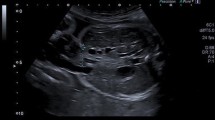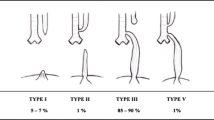Abstract
The current diagnostic accuracy and perinatal outcome of fetuses with esophageal atresia (EA) continues to be debated. In this review, we report on our experience at a tertiary care fetal center with the prenatal ultrasound diagnosis of EA. Enrollment criteria included a small/absent stomach bubble with a normal or elevated amniotic fluid index between 2005 and 2013. Perinatal outcomes were analyzed and compared to postnatally diagnosed EA cases. Of the 22 fetuses evaluated, polyhydramnios occurred in 73 %. Three (14 %) died in utero or shortly after birth, but none had EA. In the presence of an absent/small stomach and polyhydramnios, the positive predictive value for EA was 67 %. In fetal EA cases confirmed postnatally (group 1, n = 11), there were no differences in gestational age, birthweight, or mortality when compared to postnatally diagnosed infants (group 2, n = 59). Group 1 was associated with long-gap EA, need for esophageal replacement, and increased hospital length of stay. When taken in context with the current literature, we conclude that ultrasound findings suggestive of EA continue to be associated with a relatively high rate of false positives. However, among postnatally confirmed cases, there is an increased risk for long-gap EA and prolonged hospitalization.

Similar content being viewed by others
References
Torfs CP, Curry CJ, Bateson TF (1995) Population-based study of tracheoesophageal fistula and esophageal atresia. Teratology 52:220–232
Haight C (1947) Congenital atresia of the esophagus with tracheoesophageal fistula. Surg Gynecol Obstet 84:504–506
Spitz L, Kiely EM, Morecroft JA et al (1994) Oesophageal atresia: at-risk groups for the 1990s. J Pediatr Surg 29:723–725
Lopez PJ, Keys C, Pierro A et al (2006) Oesophageal atresia: improved outcome in high-risk groups? J Pediatr Surg 41:331–334
Rintala RJ, Sistonen S, Pakarinen MP (2009) Outcome of esophageal atresia beyond childhood. Semin Pediatr Surg 18:50–56
Zemlyn S (1981) Prenatal detection of esophageal atresia. J Clin Ultrasound 9:453–454
Eyheremendy E, Pfister M (1983) Antenatal real-time diagnosis of esophageal atresias. J Clin Ultrasound 11:395–397
Pretorius DH, Drose JA, Dennis MA et al (1987) Tracheoesophageal fistula in utero. Twenty-two cases. J Ultrasound Med 6:509–513
Nicolaides KH, Snijders RJ, Cheng HH et al (1992) Fetal gastro-intestinal and abdominal wall defects: associated malformations and chromosomal abnormalities. Fetal Diagn Ther 7:102–115
Dell’Agnola CA, Tomaselli V, Teruzzi E et al (1993) Prenatal diagnosis of gastrointestinal obstruction: a correlation between prenatal ultrasonic findings and postnatal operative findings. Prenat Diagn 13:629–632
Stringer MD, McKenna KM, Goldstein RB et al (1995) Prenatal diagnosis of esophageal atresia. J Pediatr Surg 30:1258–1263
Sparey C, Jawaheer G, Barrett AM et al (2000) Esophageal atresia in the Northern Region Congenital Anomaly Survey, 1985-1997: prenatal diagnosis and outcome. Am J Obstet Gynecol 182:427–431
Borsellino A, Zaccara A, Nahom A et al (2006) False-positive rate in prenatal diagnosis of surgical anomalies. J Pediatr Surg 41:826–829
Pretorius DH, Gosink BB, Clautice-Engle T et al (1988) Sonographic evaluation of the fetal stomach: significance of nonvisualization. AJR Am J Roentgenol 151:987–989
McKenna KM, Goldstein RB, Stringer MD (1995) Small or absent fetal stomach: prognostic significance. Radiology 197:729–733
Kalish RB, Chasen ST, Rosenzweig L et al (2003) Esophageal atresia and tracheoesophageal fistula: the impact of prenatal suspicion on neonatal outcome in a tertiary care center. J Perinat Med 31:111–114
Pedersen RN, Calzolari E, Husby S et al (2012) Oesophageal atresia: prevalence, prenatal diagnosis and associated anomalies in 23 European regions. Arch Dis Child 97:227–232
Houben CH, Curry JI (2008) Current status of prenatal diagnosis, operative management and outcome of esophageal atresia/tracheo-esophageal fistula. Prenat Diagn 28:667–675
Brantberg A, Blaas HG, Haugen SE et al (2007) Esophageal obstruction-prenatal detection rate and outcome. Ultrasound Obstet Gynecol 30:180–187
Quarello E, Saada J, Desbriere R et al (2011) Prenatal diagnosis and evaluation of defect length in esophageal atresia using direct and indirect (tracheal print) signs. Ultrasound Obstet Gynecol 38:225–228
Kalache KD, Wauer R, Mau H et al (2000) Prognostic significance of the pouch sign in fetuses with prenatally diagnosed esophageal atresia. Am J Obstet Gynecol 182:978–981
Langer JC, Hussain H, Khan A et al (2001) Prenatal diagnosis of esophageal atresia using sonography and magnetic resonance imaging. J Pediatr Surg 36:804–807
Shulman A, Mazkereth R, Zalel Y et al (2002) Prenatal identification of esophageal atresia: the role of ultrasonography for evaluation of functional anatomy. Prenat Diagn 22:669–674
Houfflin-Debarge V, Bigot J (2011) Ultrasound and MRI prenatal diagnosis of esophageal atresia: effect on management. J Pediatr Gastroenterol Nutr 52(Suppl 1):S9–S11
Solt I, Rotmensch S, Bronshtein M (2010) The esophageal ‘pouch sign’: a benign transient finding. Prenat Diagn 30:845–848
Levine D, Barnewolt CE, Mehta TS et al (2003) Fetal thoracic abnormalities: MR imaging. Radiology 228:379–388
Rao SB, Slovis TL, Cradock TV et al (1978) Visualization of the intestinal tract by amniography in a fetus with esophageal atresia. Pediatr Radiol 7:241–242
Fallon SC, Ethun CG, Olutoye OO et al (2014) Comparing characteristics and outcomes in infants with prenatal and postnatal diagnosis of esophageal atresia. J Surg Res 190:242–245
Salomon LJ, Sonigo P, Ou P et al (2009) Real-time fetal magnetic resonance imaging for the dynamic visualization of the pouch in esophageal atresia. Ultrasound Obstet Gynecol 34:471–474
Czerkiewicz I, Dreux S, Beckmezian A et al (2011) Biochemical amniotic fluid pattern for prenatal diagnosis of esophageal atresia. Pediatr Res 70:199–202
Muller C, Czerkiewicz I, Guimiot F et al (2013) Specific biochemical amniotic fluid pattern of fetal isolated esophageal atresia. Pediatr Res 74:601–605
Author information
Authors and Affiliations
Corresponding author
Rights and permissions
About this article
Cite this article
Kunisaki, S.M., Bruch, S.W., Hirschl, R.B. et al. The diagnosis of fetal esophageal atresia and its implications on perinatal outcome. Pediatr Surg Int 30, 971–977 (2014). https://doi.org/10.1007/s00383-014-3562-2
Accepted:
Published:
Issue Date:
DOI: https://doi.org/10.1007/s00383-014-3562-2




